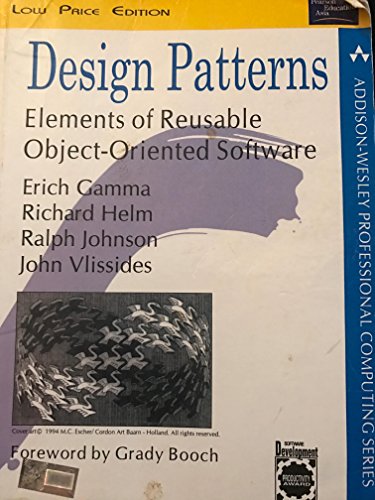PDF Design patterns: elements of reuseable object-oriented software
Table Of Content

The Decorator pattern allows for dynamic behavior extension at runtime. Developers can learn how to apply the Decorator pattern to add new functionality to classes without modifying their structure. Factory Method and Abstract Factory patterns promote the concept of object creation delegation. The authors explain how these patterns encapsulate object creation logic, promoting loose coupling and extensibility. There are 5 design patterns in the creational design patterns category. The mediator pattern is used to reduce coupling between classes that communicate with each other.
Behavioral
Today we see these patterns in many programs and developers on different platforms are more and more aware of these first defined design patterns. If you are software developer then this is must-have book for you. At its core, "Design Patterns" is about building flexible and extensible software architectures. The book emphasizes the importance of designing systems with an eye on future changes and requirements.
Others also viewed
The Flyweight Pattern defines a structure for sharing objects. However, applications that use lots of objects must pay careful attention to the cost of each object. Overall, the Flyweight pattern’s effectiveness depends heavily on how and where it’s used.
Scikit-Learn Design Principles. Elegant, Progressive, and Pragmatic by Mark A. Brennan - Towards Data Science
Scikit-Learn Design Principles. Elegant, Progressive, and Pragmatic by Mark A. Brennan.
Posted: Tue, 24 Sep 2019 07:00:00 GMT [source]
Software Reuse: Principles, Patterns, Prospects
Patterns allow designers to create more flexible, elegant, and ultimately reusable designs without having to rediscover the design solutions themselves. Through its practical examples, real-world case studies, and emphasis on object-oriented principles, "Design Patterns" enables software engineers to build flexible, maintainable, and efficient software systems. By adopting the patterns presented in the book, developers can enhance their problem-solving capabilities, promote code reuse, and embrace a design-centric approach to software development.
The concepts discussed in "Design Patterns" align harmoniously with the principles of clean code and software craftsmanship. By leveraging design patterns, developers can create clean, understandable code that adheres to best practices in software development. To fully comprehend and implement design patterns effectively, software engineers must be well-versed in the SOLID principles. The authors refer to inheritance as white-box reuse, with white-box referring to visibility, because the internals of parent classes are often visible to subclasses. The composite pattern describes a way to create tree structures using objects and object groups.
Search code, repositories, users, issues, pull requests...
People often use the Factory Method as the standard way to create objects. One thing expert designers know not to do is solve every problem from first principle. Rather, they reuse solutions that have worked for them in the past. When I see patterns in my programs, I consider it a sign of trouble. The shape of a program should reflect only the problem it needs to solve. Any other regularity in the code is a sign, to me at least, that I'm using abstractions that aren't powerful enough-- often that I'm generating by hand the expansions of some macro that I need to write.
Sometimes acquaintance is called 'association' or the 'using' relationship. Acquaintance objects may request operations of each other, but they are not responsible for each other. Acquaintance is a weaker relationship than aggregation and suggests much looser coupling between objects, which can often be desirable for maximum maintainability in designs.

Using Structuremap in legacy ASP.NET MVC applications
A singleton is an object whose class can only have one instance. A singleton class ensures that only one instance of the class can be created. The pattern is often called an anti-pattern because it may lead to high coupling of components. The proxy pattern is used to provide a surrogate or placeholder object, which references an underlying object. The proxy provides the same public interface as the underlying subject class, adding a level of indirection by accepting requests from a client object and passing these to the real subject object as necessary. The adapter pattern is a design pattern that is used to allow two incompatible types to communicate.
Other editions - View all
Directly from programming where they had different implementations. GoF just gathered these patterns together and generalized these. Whether you are embarking on your programming journey or seeking to refine your design skills, this book is an essential read that will elevate your understanding of software architecture and design patterns. "Design Patterns" guides software engineers in writing clean and efficient code by promoting encapsulation, modularization, and loose coupling. The book reinforces the idea that clean code and design patterns are interconnected and complement each other in the pursuit of well-crafted software.

Furthermore, they claim that a way to avoid this is to inherit only from abstract classes—but then, they point out that there is minimal code reuse. The Command pattern encapsulates a request as an object, allowing for parameterization, queuing, and logging of requests. Developers can learn how the Command pattern decouples sender and receiver logic. Behavioral Patterns describe patterns of objects/classes and the patterns communication between them. The Factory Method Pattern makes a design more customizable and only a little more complicated.
The authors also discuss so-called parameterized types, which are also known as generics (Ada, Eiffel, Java, C#, VB.NET, and Delphi) or templates (C++). These allow any type to be defined without specifying all the other types it uses—the unspecified types are supplied as 'parameters' at the point of use. The book started at a birds-of-a-feather session at the 1990 OOPSLA meeting, "Towards an Architecture Handbook", where Erich Gamma and Richard Helm met and discovered their common interest. They were later joined by Ralph Johnson and John Vlissides.[6] The book was originally published on 21 October 1994, with a 1995 copyright, and was made available to the public at the 1994 OOPSLA meeting.
AB - Capturing a wealth of experience about the design of object-oriented software, four top-notch designers present a catalog of simple and succinct solutions to commonly occurring design problems. They then go on to systematically name, explain, evaluate, and catalog recurring designs in object-oriented systems. All patterns are compiled from real systems and are based on real-world examples. Each pattern also includes code that demonstrates how it may be implemented in object-oriented programming languages like C++ or Smalltalk. N2 - Capturing a wealth of experience about the design of object-oriented software, four top-notch designers present a catalog of simple and succinct solutions to commonly occurring design problems. Each pattern describes the circumstances in which it is applicable, when it can be applied in view of other design constraints, and the consequences and trade-offs of using the pattern within a larger design.
It shows that you can always replace inheritance with object composition as a mechanism for code reuse. Throughout the book, the authors provide case studies and real-world examples of applying design patterns to practical software scenarios. These examples demonstrate the contexts in which design patterns shine and how they can be adapted to solve specific problems. "Design Patterns" assumes a strong familiarity with object-oriented principles, such as encapsulation, inheritance, and polymorphism. The book builds upon these foundational concepts to showcase how design patterns leverage object-oriented principles to address specific design challenges. "Design Patterns" discusses the strengths and weaknesses of each pattern, enabling developers to choose the most appropriate pattern for a given situation.
This provides a cleaner implementation of real-world objects and allows the implementation details to be changed easily. Most behavioral design patterns are specifically concerned with communication between objects. They use inheritance to compose interfaces and define ways to compose objects to obtain new functionality. An object with methods to create objects without specifying the exact class that will be created. Depending on the concrete factory implementation objects with different classes are created.
Where one class relies upon a specific interface that is not implemented by another class, the adapter acts as a translator between the two types. Creational patterns are ones that create objects, rather than having to instantiate objects directly. This gives the program more flexibility in deciding which objects need to be created for a given case.
While "Design Patterns" was first published in 1994, the patterns it presents remain relevant to modern software development. The book emphasizes that design patterns are not tied to specific programming languages or technologies but rather represent fundamental principles that transcend time and trends. By adopting design patterns, software engineers can design scalable, maintainable architectures that are resilient to change.
Comments
Post a Comment